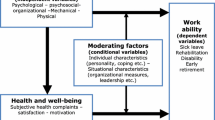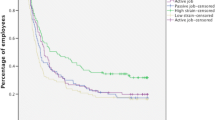Abstract
Purpose
To investigate whether psychosocial job demands (work pace and quantitative demands) and job resources (influence at work and quality of leadership) predict long-term sickness absence (LTSA) for more than three consecutive weeks in four occupational groups.
Methods
Survey data pooling 39,408 respondents were fitted to a national register containing information on payments of sickness absence compensation. Using multi-adjusted Cox regression, respondents were followed for an 18-month follow-up period to assess risk of LTSA.
Results
In the entire study population, low and medium levels of influence at work and low quality of leadership predicted a significantly increased risk of LTSA, whereas medium levels of quantitative demands predicted a significantly reduced risk of LTSA. For employees working with clients and for office workers, low and medium influence at work associated with a significantly increased risk of LTSA. For employees working with clients, low quality of leadership predicted a significantly increased risk of LTSA. For manual workers, low influence at work predicted a significantly increased risk of LTSA and medium quantitative demands were associated with a significantly reduced risk of LTSA. For employees working with customers, medium quantitative demands predicted a significantly reduced risk of LTSA. Finally, in predicting LTSA, we found significant interaction effects between job demands and job resources.
Conclusions
The study indicates that a lack of job resources—particularly influence at work—are more important predictors of LTSA than high job demands.
Similar content being viewed by others
References
Bakker AB, Demerouti E (2007) The job demands-resources model: state of the art. J Manag Psychol 22:309–328
Borritz M, Rugulies R, Bjorner JB, Villadsen E, Mikkelsen OA, Kristensen TS (2006) Burnout among employees in human service work: design and baseline findings of the PUMA study. Scand J Public Health 34:49–58
Borritz M, Christensen KB, Bültmann U, Rugulies R, Lund T, Andersen I, Villadsen E, Diderichsen F, Kristensen TS (2010) Impact of burnout and psychosocial work characteristics on future long-term sickness absence: prospective results of the Danish Puma study among human service workers. J Occup Environ Med 58:964–970
Burr H, Bjorner JB, Kristensen TS, Tüchsen F, Bach E (2003) Trends in the Danish work environment in 1990–2000 and their associations woth labor-force changes. Scand J Work Environ Health 29:270–279
Christensen KB, Nielsen ML, Rugulies R, Smith-Hansen L, Kristensen TS (2005) Workplace levels of psychosocial factors as prospective predictors of registered sickness absence. J Occup Environ Med 47:933–940
Christensen KB, Feveile H, Labriola M, Lund T (2008) The impact of psychosocial work environment factors on the risk of disability pension in Denmark. Eur J Public Health 18:235–237
Clausen T, Borg V (2011) Job demands, job resources and meaning at work. J Manag Psychol 26:665–681
Clausen T, Nielsen K, Carneiro IG, Borg V (2012) Job demands, job resources and long-term sickness absence in the Danish eldercare services: a prospective analysis of register-based outcomes. J Adv Nurs 68:127–136
Clausen T, Andersen LL, Holtermann A, Jorgensen AFB, Aust B, Rugulies R (2013) Do self-reported psychosocial working conditions predict low back pain after adjustment for both physical work load and depressive symptoms? A prospective study among female eldercare workers. Occup Environ Med. Online first
Csikszentmihalyi M (2000) Beyond boredom and anxiety (Original work published 1975). Jossey-Bass, San Francisco
Deci EL, Ryan RM (1985) Intrinsic motivation and self-determination in human behavior. Plenum, New York
Feveile H, Olsen O, Burr H, Bach E (2007) The Danish work environment cohort study 2005: from idea to sampling design. Stat Transit 8:441–458
Gimeno D, Benavides FG, Amick BC III, Benach J, Martinez JM (2004) Psychosocial factors and work related sickness absence among permanent and non-permanent employees. J Epidemiol Community Health 58:870–876
Hauke A, Flintrop J, Brun E, Rugulies R (2011) The impact of work-related psychosocial stressors on the onset of musculoskeletal disorders in specific body regions: a review and meta-analysis of 54 longitudinal studies. Work Stress 25:243–256
Head J, Kivimäki M, Martikainen P, Vahtera J, Ferrie JE, Marmot MG (2006) Influence of change in psychosocial work characteristics on sickness absence: the Whitehall II study. J Epidemiol Community Health 60:55–61
Hjollund NH, Larsen FB, Andersen JH (2007) Register-based follow-up of social benefits and other transfer payments: accuracy and degree of completeness in a Danish interdepartmental administrative database compared with a population-based survey. Scand J Public Health 35:497–502
Hobfoll SE (2001) The influence of culture, community, and the nested-self in the stress process: advancing conservation of resources theory. Appl Psychol-Int Rev 50:337–370
Hobfoll SE (2002) Social and psychological resources and adaptation. Rev Gen Psychol 6:307–324
Katsahian S, Latouche A, Mary J (2008) Practical methodology of meta-analysis of individual patient datausing a survival outcome. Contemp Clin Trials 29:220–230
Keyes CLM (2007) Promoting and protecting mental health as flourishing: a complementary strategy for improving national mental health. Am Psychol 62:95–108
Kivimäki M, Nyberg ST, Batty GD, Fransson EI, Heikkilä K, Alfredsson L, Bjorner JB et al (2013) Web appendix 2 for publication: job strain as a risk factor for coronary heart disease: a collaborative meta-analysis of individual participant data. The Lancet 380:1491–1497
Kristensen TS, Hannerz H, Hogh A, Borg V (2005) The Copenhagen psychosocial questionnaire: a tool for the assessment and improvement of the psychosocial work environment. Scand J Work Environ Health 31:438–449
Lidwall U, Marklund S (2006) What is healthy work for women and men? A case-control study of gender- and sector-specific effects of psycho-social working conditions on long-term sickness absence. Work 27:153–163
Lidwall U, Bergendorf S, Voss M, Marklund S (2009) Long-term sickness absence: changes in risk factors and the population at risk. Int J Occup Med Environ Health 22:157–168
Lund T, Labriola M, Christensen KB, Bültmann U, Villadsen E, Burr H (2005) Psychosocial work environment exposures as risk factors for long-term sickness absence among Danish employees: results From DWECS/DREAM. J Occup Environ Med 47:1141–1147
Lund T, Kivimäki M, Labriola M, Villadsen E, Christensen KB (2008) Using administrative sickness absence data as a marker of future disability pension: the prospective DREAM study of Danish private sector employees. Occup Environ Med 65:28–31
Madsen IEH, Burr H, Diderichsen F, Pejtersen JH, Borritz M, Bjorner JB, Rugulies R (2011) Work-related violence and incidence use of psychotropics. Am J Epidemiol 174:1354–1362
Nakamura J, Csikszentmihalyi M (2005) The concept of flow. In: Snyder CR, Lopez SJ (eds) Handbook of positive psychology. Oxford University Press, New York, pp 89–105
Nielsen ML, Rugulies R, Christensen KB, Smith-Hansen L, Bjorner JB, Kristensen TS (2004) Impact of the psychosocial work environment on registered absence from work: a two-year longitudinal study using the IPAW cohort. Work Stress 18:323–335
Nielsen ML, Rugulies R, Christensen KB, Smith-Hansen L, Kristensen TS (2006) Psychosocial work environment predictors of short and long spells of registered sickness absence during a 2-year follow up. J Occup Environ Med 48:591–598
Nordic Council of Ministers (2008) Nordic statistical yearbook 2008. Nordic Council of Ministers, Copenhagen
Pejtersen JH, Kristensen TS, Borg V, Bjorner JB (2010) The second version of Copenhagen psychosocial questionnaire (COPSOQII). Scand J Public Health 38(Suppl 3):8–24
Podsakoff PM, MacKenzie SB, Lee JY, Podsakoff NP (2003) Common method biases in behavioral research: a critical review of the literature and recommended remedies. J Appl Psychol 88:879–903
Podsakoff NP, LePine JA, LePine MA (2007) Differential challenge stressor-hindrance stressor relationships with job attitudes, turnover intentions, turnover, and withdrawal behavior: a meta-analysis. J Appl Psychol 92:438–454
Robroek SJ, Schuring M, Croezen S, Stattin M, Burdorf A (2012) Poor health, unhealthy behaviors, and unfavorable work characteristics influence pathways of exit from paid employment among older workers in Europe: a pour year follow-up study. Scand J Work Environ Health. Online first
Rugulies R, Christensen KB, Borritz M, Villadsen E, Bültmann U, Kristensen TS (2007) The contribution of the psychosocial work environment to sickness absence in human service workers: results of a 3-year follow-up study. Work Stress 21:293–311
Schaufeli WB, Bakker AB (2004) Job demands, job resources, and their relationship with burnout and engagement: a multi-sample study. J Organ Behav 25:293–315
Wethje A, Borg V (2003) Sickness absence, intention to change jobs and intentions to retire from the labour market (Sygefravær, intentioner om jobskifte samt intentioner om ophør fra arbejdsmarkedet). Danish Nurses Association and National Research Centre for the Working Environment, Copenhagen
Wethje A, Borg V (2008) Stress among nurses (Stress blandt sygeplejersker). Danish Nurses Association and the National Research Centre for the Working Environment, Copenhagen
Acknowledgments
The authors wish to acknowledge the contributions of Ebbe Villadsen, Jørgen Vinsløv Hansen and Ida E. H. Madsen, The National Research Centre for the Working Environment and Lars Smith-Hansen, Clinical Research Centre, Hvidovre Hospital, Denmark. This study was funded from a grant from the Danish Working Environment Research Fund (Grant Number 16-2009-03).
Conflict of interest
The authors declare that they have no conflict of interests.
Author information
Authors and Affiliations
Corresponding author
Rights and permissions
About this article
Cite this article
Clausen, T., Burr, H. & Borg, V. Do psychosocial job demands and job resources predict long-term sickness absence? An analysis of register-based outcomes using pooled data on 39,408 individuals in four occupational groups. Int Arch Occup Environ Health 87, 909–917 (2014). https://doi.org/10.1007/s00420-014-0936-7
Received:
Accepted:
Published:
Issue Date:
DOI: https://doi.org/10.1007/s00420-014-0936-7




